Take a peek inside the technology bringing climate-neutral synthetic natural gas and methanol to the world.
Renewable synthetic fuels like synthetic natural gas and methanol are pivotal in decarbonizing the economy, with potential applications in industrial processes, chemical manufacturing, shipping and much, much more. Discover takes a peek inside the processes and technologies that are helping to bring these fuels to the world.
By Florian Bayer
They were simply ahead of their time. In 2013, in cooperation with Audi AG, MAN Energy Solutions helped build Europe’s first and, with a six-megawatt capacity, still the largest Power-to-Gas plant to provide vehicles with a cleaner fuel. They equipped the plant, located in Werlte, in Northern Germany, with a key piece of technology: a state-of-the-art methanation reactor that transforms hydrogen and carbon dioxide into climate-neutral synthetic natural gas.
Now they’re at it again, but this time in Punta Arenas, in Southern Chile, where they’re providing a reactor for the world’s first integrated pilot plant for manufacturing synthetic gasoline. Synthetic fuels like these will play a crucial role in decarbonizing and coupling all sectors. Able to be used in the same way as fossil fuels but without contributing to global warming, synthetic fuels can be produced for air travel, trucking, shipping and the generation of electricity. But just how are these fuels made?
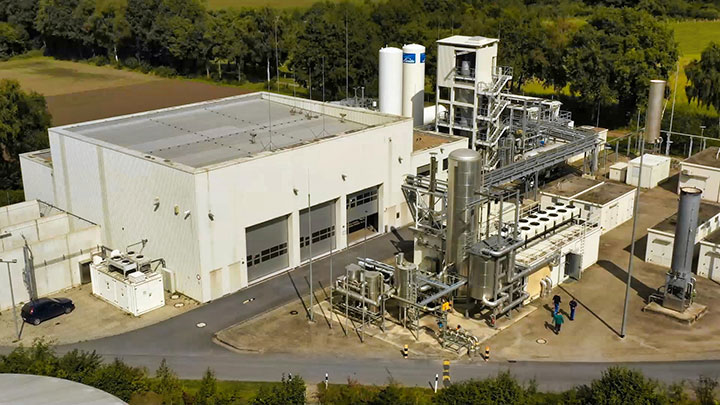
First commissioned in 2013, the Power-to-Gas plant in Werlte, Germany, is the largest in Europe, producing synthetic natural gas for mobility and shipping. ©Cassandra Media
How to build a better gas
Let’s start with synthetic natural gas or SNG, which is still being made at the plant in Werlte, though it’s now owned by and operated by Kiwi AG. In fact, the plant recently provided SNG for the container ship ElbBlue, which in September of last year became the world’s first container ship to use the alternative fuel and reduced its carbon dioxide emissions by some 56 tons for a trip from Brunsbüttel, Germany to Rotterdam, the Netherlands, showing the potential of synthetic fuels.
SNG – also known as green methane or e-gas – is derived from Power-to-X technologies that use renewable energy to separate water (H2O) into its basic components. The hydrogen (H2) can either be used directly as a fuel or, in the case of SNG, bound to captured carbon atoms to form a new chemical compound.
Sounds simple enough, right? But this is in fact a highly complex process, requiring intense pressures and temperatures. The key is the methanation reactor: Think of it as a large heat exchanger equipped with up to thousands of tubes, and inside these tubes are small pellets, each one no longer than a few millimeters, that act as a catalyst to speed up the transformation of hydrogen and carbon dioxide into methane.
We’re at a point of no return when it comes to going green.
Methanation: the road to net-zero emissions
"Small particles, but with a large impact,” says Christian Schuhbauer, Head of New Technologies at MAN Energy Solutions in Deggendorf, Germany, where the company has spent more than a decade researching synthetic fuels. “Without the catalyst, the entire reaction wouldn’t take place.”
The underlying methanation process was first described by the chemist Paul Sabatier, who won the Nobel Prize for Chemistry in 1912. Along with the nickel catalysts, it requires high pressures and temperatures of close to 300˚C. To make SNG truly sustainable,
of course, the process needs to use Carbon Capture and Utilization technology to trap and use carbon emissions from biomass, industrial processes or directly from the atmosphere. In this way, the emissions are balanced out with the offsets from its
removal, making synthetic methane entirely climate-neutral.
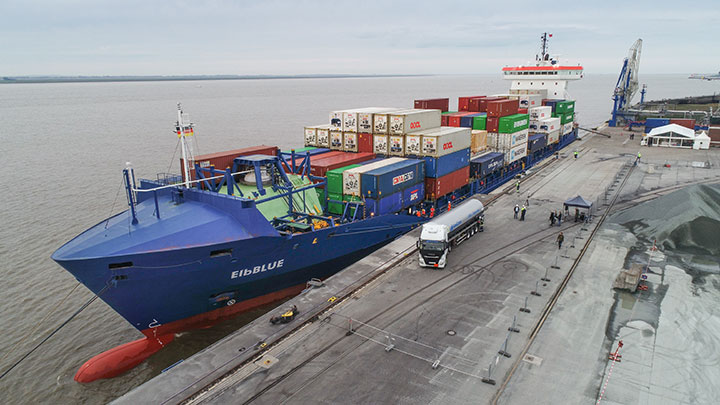
On September 29, 2021, the ElbBlue became the world’s first ship to use synthetic natural gas, receiving around 20 tons of the fuel at the harbor in Brunsbüttel, Germany. ©Cassandra Media
Where can SNG be used?
Here in Europe, we import a large amount of natural gas (around 90 percent), and it consists almost primarily of methane, a chemical compound made up of one carbon atom bonded to four hydrogen atoms. In the textbooks, the scientific shorthand for methane looks like this: CH4. Many households depend on it for heating, but also power plants, the chemical sector and industry. SNG can help decarbonize all these sectors and at the same time counterbalance possible supply shortages of fossil natural gas.
As a matter of fact, SNG and other hydrogen-based fuels, such as methanol, diesel, kerosene – even jet fuel – are the cornerstones to decarbonizing a wide range of economic sectors. One of the major advantages of SNG is that it can already be used today in the existing gas infrastructure without any modifications. “But let’s be honest,” adds Schuhbauer, “As much as we might like to, we can’t trick physics. Transforming carbon dioxide molecules is still more costly than using fossil fuels, but it’s well worth the price to achieve the energy turnaround, and we expect the gap to become much smaller as soon as SNG production is scaled up.”
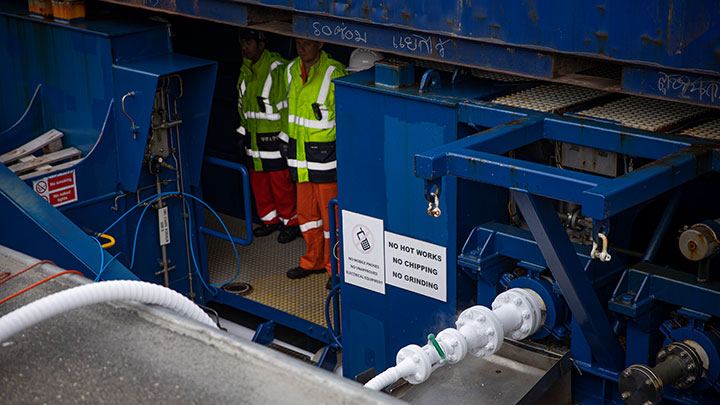
Synthetic fuels have a wide range of applications, including use in marine shipping, as with the ElbBlue seen here, but also for aviation, chemical manufacturing, industrial processes, agriculture and heating and cooling. ©Sebastian Vollmert
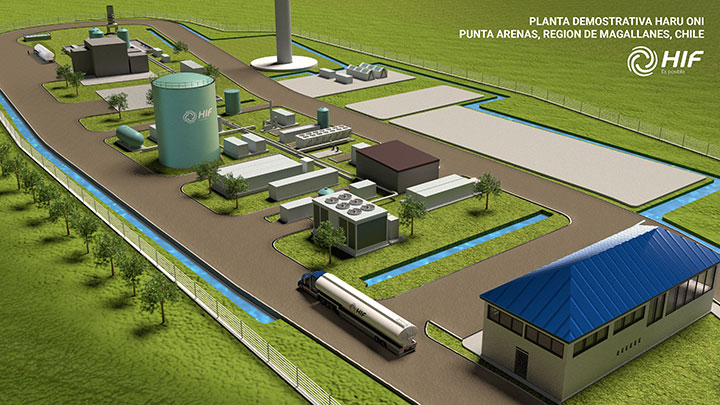
The Haru Oni pilot project takes advantage of the excellent wind conditions in southern Chile to generate synthetic, climate-neutral gasoline with the help of renewable power. ©HIF
How to build a better gasoline
Methanol synthesis (or as the scientists might put it: CH3OH) is well known from the past decades. Methanol is extremely versatile and a frequently used platform-molecule that serves as the basis in many industries. It goes without question that synthetic methanol is highly attractive, also for a greener mobility.
Exactly for this purpose, to produce greener fuel, MAN Energy Solutions is part of the construction of the Haru Oni pilot project, the world’s first integrated and industrial-scale synthetic fuels plant in Southern Chile. The plant, which will deliver synthetic methanol and gasoline for Porsche AG, is currently under construction near the city of Punta Arenas by the Chilean company HIF in cooperation with Siemens Energy and other project partners.
Why Chile? Schuhbauer points out that the country has constant wind of more than 6,000 hours per year. “Under these almost ideal circumstances, we can produce methanol in a first step and then produce gasoline out of the methanol in a second step, which will eventually compete with fossil gasoline. But to get there, the CO2 pricing, taxes and emission trading will also have be adjusted by governments worldwide.”
Methanol synthesis: decarbonizing mobility
The methanol synthesis also requires tubes and a catalyst for the hydrogenation of the carbon dioxide. “Hydrogenation” may sound like a difficult word, but it only stands for the chemical reaction of hydrogen with another compound. At the plant in Chile, in order to produce the fuel, the carbon dioxide will be extracted from the air and reacted with hydrogen to produce liquid methanol.
The methanol-synthesis unit in Chile will use proprietary CO2-to-methanol technology from Johnson Matthey (JM), a sustainable technologies company that was also responsible for the methanol reactor design. The methanol reactor, constructed by MAN Energy Solutions for the project, is relatively small because only a small quantity of synthetic methanol will be produced as part of the pilot project. Initially, the pilot plant will produce around 750 metric tons of green methanol per year. But larger, industrial-scale designs will be used by the middle of the decade to satisfy the increasing demand for cleaner fuels.
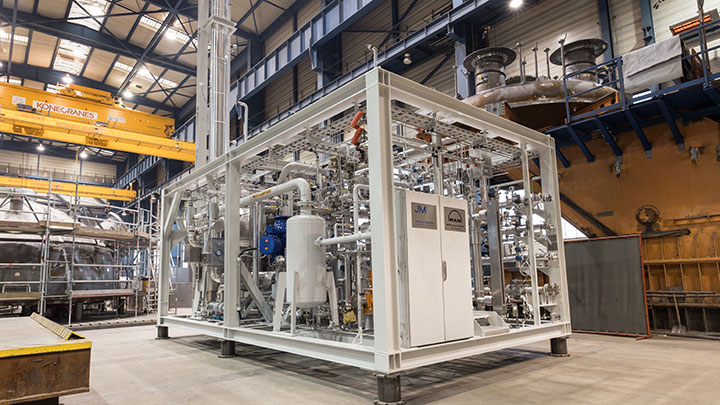
Methanol synthesis units like this one transform green hydrogen and carbon dioxide into a climate-neutral liquid fuel that can be further converted, e.g. to gasoline or kerosene. ©MAN Energy Solutions
In a further step, the methanol can then be converted into climate-neutral gasoline or kerosene. In Chile, the green gasoline being produced can be used for regular benzine cars, since the resulting fuel is hardly any different from fossil gasoline. Nevertheless, the passenger car sector still sees battery electric vehicles as the technology of choice because they use green energy directly and thus more efficiently. Yet, the increased availability of synthetic fuels will allow older car models – aka the “heritage fleet” − to stay on the road for longer. Until then, Porsche intends to use the fuel generated in Chile in several lighthouse projects, including in motorsports and Porsche Experience Centers.
Welcome to the future
Despite the big changes ahead, Schuhbauer is convinced that Power-to-X-fuels are going to be the future for certain sectors such as shipping and aviation. Not only in order to reduce dependence on fossil gas, but also to couple hard-to-electrify sectors to renewable energy and provide a bridge to a sustainable future.
“We’re at a point of no return,” says Schuhbauer, “when it comes to going green.” Never has there been such a sense of urgency bringing research and investments together. Power-to-X, methanation and methanol synthesis, such as those used by MAN Energy Solutions in Werlte and soon Chile, are here and ready. The next steps are to scale up these technologies for larger productions and extend the existing infrastructure around the world for these cleaner fuels. "We have the technology and know-how,” says Schuhbauer, “We need to just do it.”
About the author
Florian Bayer is a freelance journalist based in Vienna, Austria, where he has written for Die Zeit Online, Der Standard, and the Wiener Zeitung.
Explore more topics
-
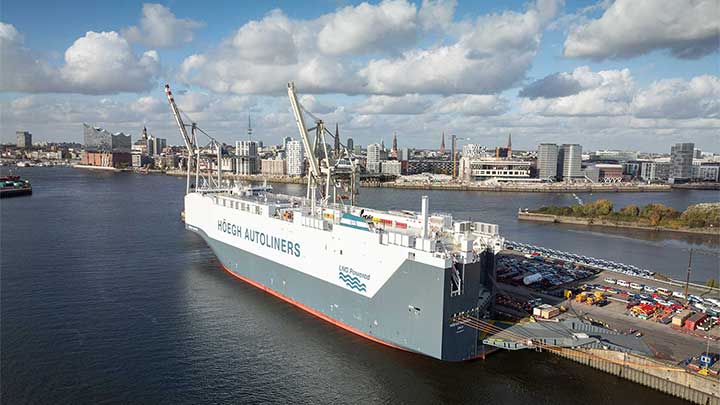
Hoegh - LNG-powered car carrier
With its first LNG-powered car carrier, Höegh Autoliners is taking a big step towards its target of net-zero by 2040. The centerpiece of the vessel is a MAN Energy Solutions MAN B&W ME-GI dual-fuel engine.
-

Maersk Halifax Retrofit
The world’s first methanol retrofit of the Very Large Container Vessel Maersk Halifax opens the doors for green fuels.
-
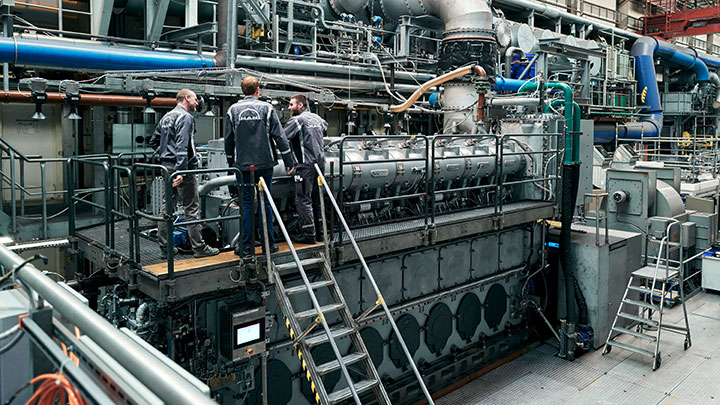
Methanol dual fuel retrofit
Engineers are now testing a retrofit for four-stroke ship engines that will enable ferry and cruise ship operators to meet the growing requirements on emission reduction with green methanol.
MAN Energy Solutions is now Everllence.
We have adopted a new brand name and moved to a new domain: www.everllence.com. This page will also be relocated there shortly. We are working on shifting all pages to www.everllence.com.
